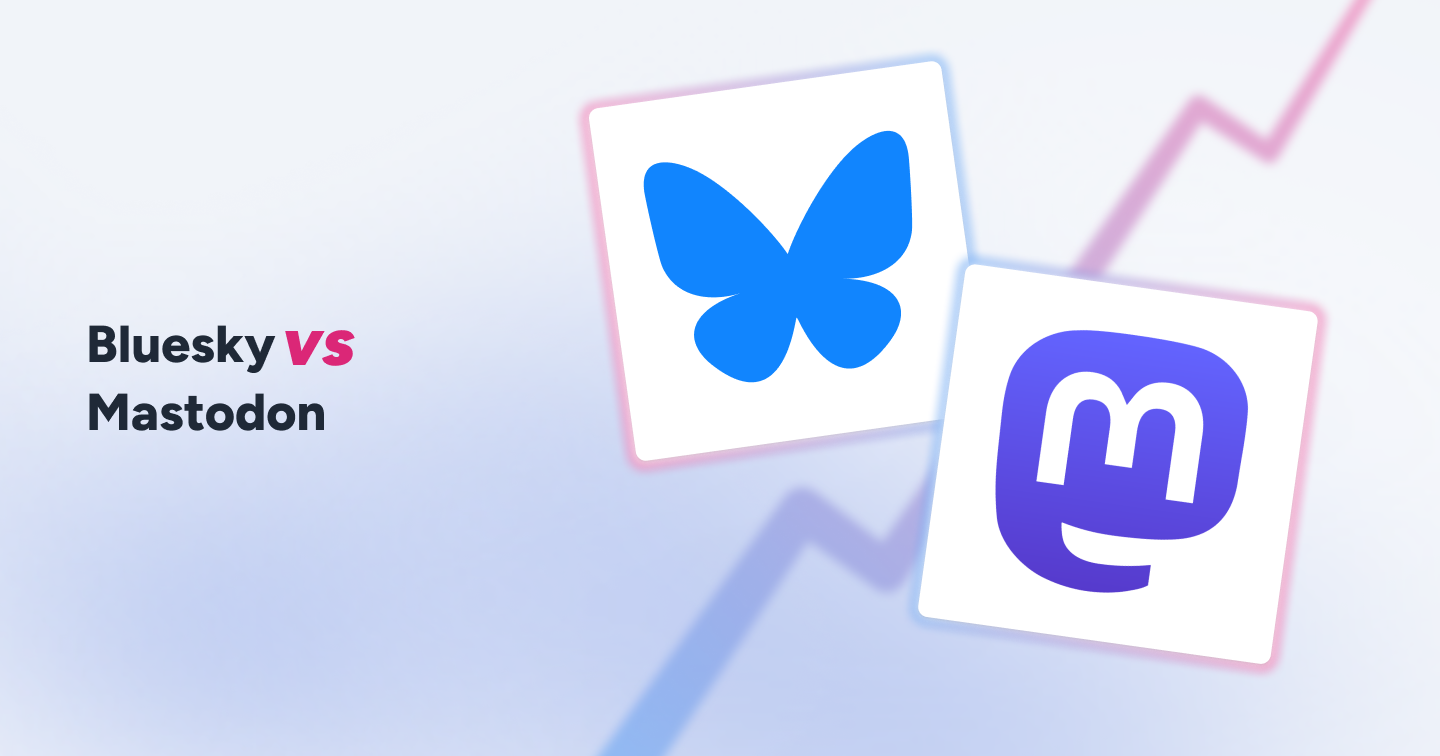Summary
- Mastodon and Bluesky are both decentralized microblogging platforms with a content format similar to Twitter and no advertisements.
- Differences: Mastodon offers close-knit communities and better engagement features, while Bluesky offers a larger user base with a simpler interface
- Similarities: Both platforms offer strong moderation tools without advertisements, monetization opportunities, or built-in analytics.
- To make a decision, assess your marketing goals, community culture, ease of onboarding, content discovery, and moderation tools.
The social web is changing—again. Today, the shift is about control.
Users are shifting away from centralized, algorithm-driven platforms and demanding greater control over their feeds.
The first platform hit by this change is Twitter. People are migrating to different open-source alternatives for cleaner feeds and a non-invasive experience.
Among the frontrunners? Mastodon and Bluesky. Both offer decentralized structure, freedom from a single algorithm, no sponsored posts, and strong moderation tools.
Each one has built a loyal user base, but if you are still debating which one is better, this blog is for you.
What is Mastodon?
Mastodon is an open-source microblogging platform founded in 2016 by Eugen Rochko. It is an alternative to Twitter that allows users to post messages (called toots), follow others, and engage in conversations, but in independent Mastodon versions.
Mastodon users can create their own servers (called instances) and are completely owned and controlled by the creator. These different servers run on different rules and algorithms, but are connected and can engage with all instances.
Different communities generate their own Mastodon versions for engaging only with users with common interests (such as art, education, fashion, and more). There are no advertisements and monetization on the platforms yet, to save users from a disruptive experience.
Mastodon originated with the idea of giving users more control over their feeds and experience.
What is Bluesky?
Bluesky is another decentralized microblogging platform with content capabilities similar to Twitter. It’s AT Protocol allows users to self-host and choose custom algorithms, as well as interoperate with others within Bluesky.
Bluesky also offers its users a custom feed option, along with the integration of third-party moderation tools, to provide a stronger grasp on their content experience.
Bluesky's interface is similar to old Twitter and is emerging as a popular Twitter alternative with more user control.
Recommended read: Learn how to use Bluesky
Mastodon vs Bluesky: How do the social media platforms differ?
1. Bluesky has a larger user base than Mastodon
Mastodon's mid-2025 user numbers are not yet available, but as of 2024, the graph has already surpassed 10 million registered users. And, Bluesky hosts 35.98 million users as of this writing.
Both platforms’ following soared after Twitter changed ownership and attracted many people who wanted cleaner algorithms. This is why both the platform’s largest age demographics (i.e., 25-34 years age group) are similar to that of Twitter.
Clearly, Bluesky offers a much wider reach. This is because Bluesky is more centralized than Mastodon, which only has 270K active users on its main server
The characteristics of both platforms are very similar, as they are typically highly privacy-conscious and critical of centralized tech control. This appeals to users who prioritize safe communities and strong moderation.
Bluesky still has more diverse audiences, as many big brands, celebrities, and different niche communities are active on the platform. On the other hand, Mastodon has more tech-savvy people.
Mastodon’s slower growth is also partly due to its anti-viral design.
2. Bluesky has a much simpler design than Mastodon
The Bluesky interface is minimal and clean to navigate in comparison to Mastodon.
The Bluesky interface is very similar to the early Twitter. It uses familiar icons, feed styles, terminology, and engagement options, making it easier for users to get started and stay engaged.
Mastodon’s UI isn’t beginner-friendly, especially for those who are used to platforms like Instagram and Twitter.
Navigating between different servers (instances) and understanding trending and live posts requires a learning curve. That said, it is not that difficult either; once you adapt to the platform, any non-tech person can easily navigate through the platform features.
Mastodon has also been gradually improving its design across mobile apps and the web, with some third-party clients offering a more polished interface.
3. Mastodon has independent feeds while Bluesky is more centralized
Mastodon operates on a federated model. That means it isn’t just one platform, but a collection of independently run servers (called instances). Each instance has its own rules, moderation policies, and community guidelines.
If you don’t like any of the existing ones, you can even host your own. You also control how content appears in your feed, who interacts with you, and what data you share.
Mastodon offers two feed types:
- Home feeds displaying posts from your following, previous engagement, news, and hashtags
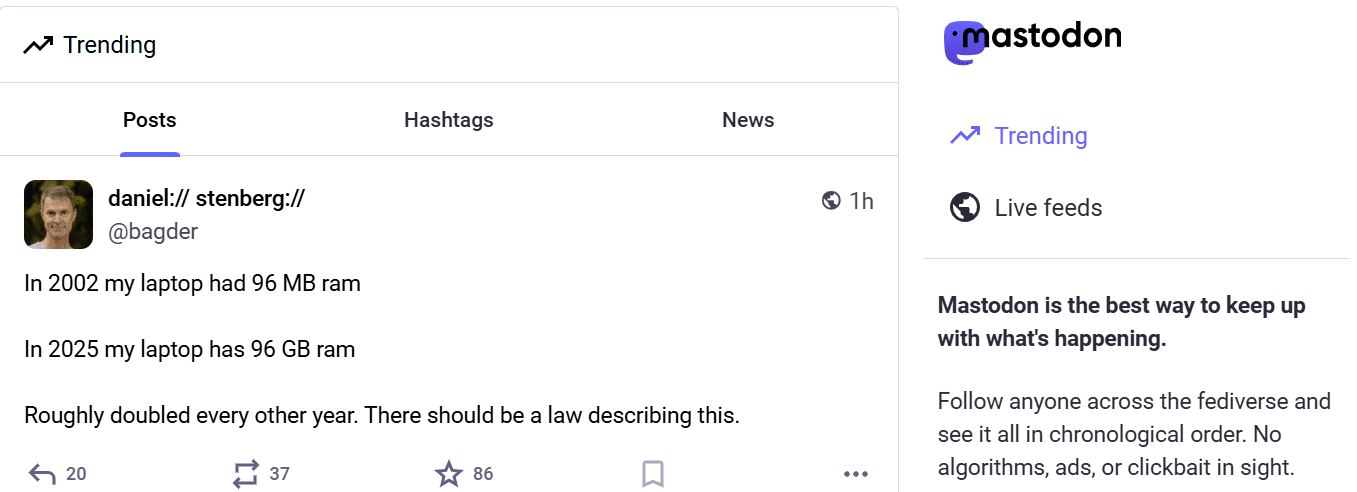
- Live feeds showcasing feeds from your own and others' servers
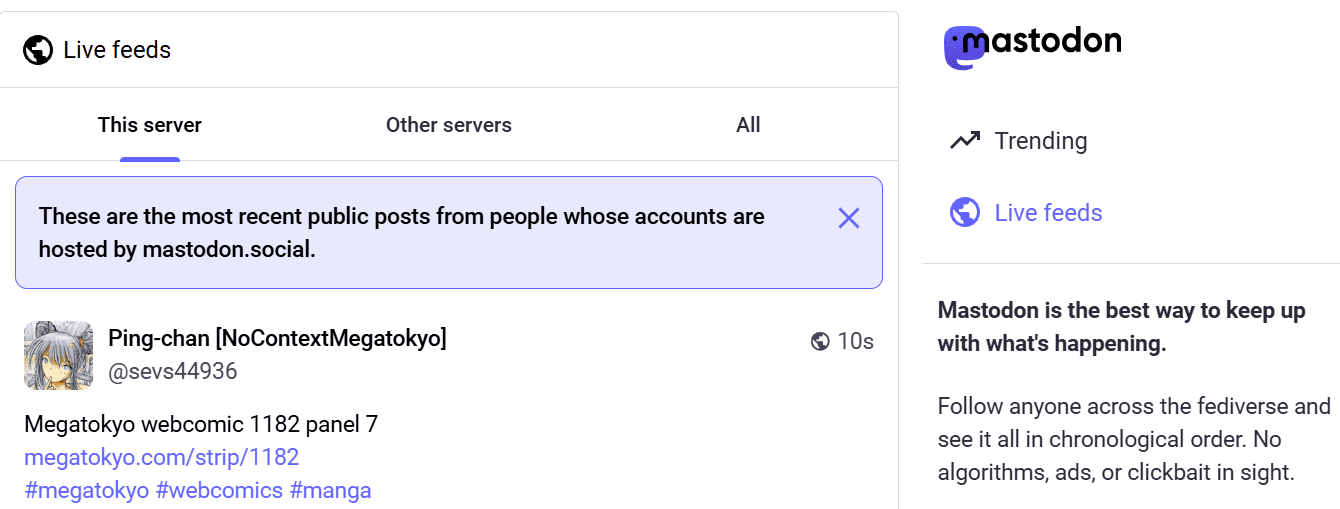
Bluesky, while also decentralized through its AT Protocol, is more centralized in service at this stage. Most users are still on the main Bluesky-managed service.
Bluesky allows users to pick or create custom feeds and install them for an alternate algorithm, which Mastodon currently does not support.
Along with custom feeds, Bluesky offers users three feeds:
- Default feeds as per your previous engagement
- Following feeds to showcase posts from your followers
- Community feeds that display your group activity
4. Both platforms offer strong moderation services
Bluesky offers strong built-in moderation tools. You can block accounts, mute problematic posts based on specific keywords and tags, and report posts to the platform.
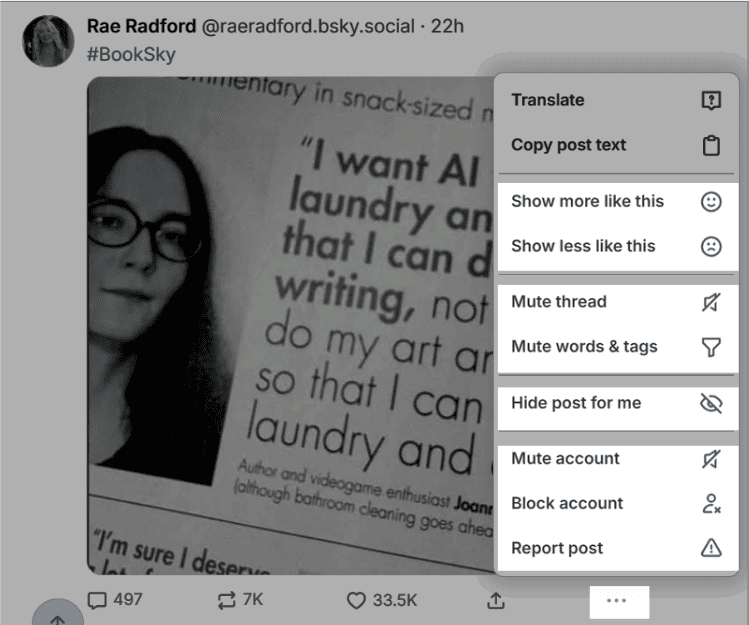
It also allows for third-party moderation services to add a more stricter surveillance and give you results based on your chosen moderation preferences. You can use it to flag AI-generated content that the platform does not currently offer support for.
On Mastodon, users can create customized rules for their server, block an account, or the entire server.

5. Mastodon offers a higher character limit and engagement features
Both platforms have the same microblogging content format. You can post short text posts (with images, videos & GIFs) and use threads (similar to Twitter) for longer conversations.
Mastodon offers slightly longer character limits for a single post, allowing users to use 500 characters, whereas on BlueSky limit is 300 characters. This allows Mastodon users to add more context without needing to add a thread.
Mastodon also gives users a few more ways to interact; you can create polls, favorite posts, boost them (kind of like retweets), and even save posts for later.
Bluesky is keeping things simple for now with only likes, reposts, and replies, no polls or save-for-later options yet.
Neither platform supports native content scheduling, and users must use third-party tools to schedule posts.
6. Bluesky offers more engagement
Engagement on Mastodon is lower than on Bluesky.
Due to Bluesky being more centralized, it is simpler and easier to use and has more active users currently.
Bluesky offers pre-made online communities that let users follow multiple feeds based on interests, with easy content discovery and engagement tools that make it a much easier and more dynamic platform for users.
Whereas, on Mastodon, there is no algorithm manipulating your timeline, it’s purely chronological, and the lack of a centralized feed makes it harder for users to find unless you're actively engaged in specific communities.
7. No ads and monetisation on both platforms
Neither of the platforms supports native advertisements, sponsored posts, or algorithms prioritizing content based on commercial interests.
Both the platform’s models are intentionally designed to keep user attention organic, not to offer a disruptive experience.
If creators want to monetize their content, they typically link out to external platforms like Patreon or Substack, but Mastodon itself doesn’t facilitate or promote these models.
Similarly, Bluesky doesn’t give creators money directly; it gives them better traffic (in comparison to Mastodon) by not downranking links, which creators can convert into revenue via Patreon or YouTube links.
Bluesky is still evolving and has plans for rolling out a subscription model soon, as the CEO confirms.
8. Mastodon’s communities are close-knit, Bluesky’s are scalable
Mastodon is a completely decentralized platform because it is spread across thousands of independently-run servers (or instances), each of which has its own unique culture, rules, and social norms.
These instances are also Mastodon’s pre-made online communities on different topics. But creating your own server on Mastodon requires several technical steps and can be challenging for new users.
Bluesky, on the other hand, has a broader appeal and is simpler in functioning. Bluesky allows users to easily join communities.
The platforms have over 200K pre-made online communities for their new users. For this, you simply have to use the search tab and type keywords to find communities and join them.
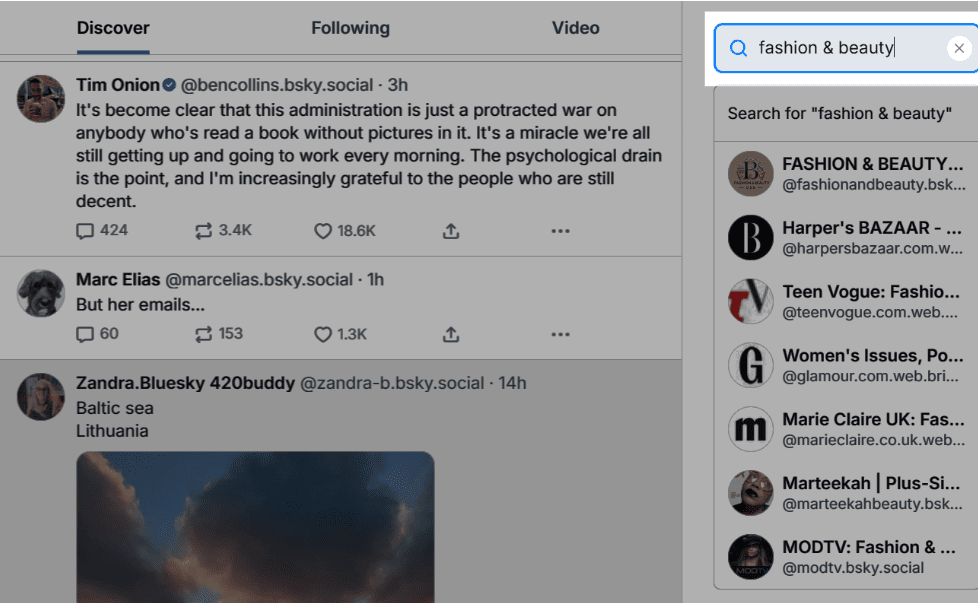
Users can also use Skyfeed or Bluesky Directory for more custom feeds across topics like arts, politics, education, fashion, and more.
Both platforms offer stronger moderation services, so users must be intentional in conversations to maintain the decorum of the group.
9. Neither platform offers native-analytics
There is no native analytics dashboard on Mastodon and Bluesky, unlike Twitter. You have to install third-party services to analyze your platform’s performance.
For Bluesky, you can use BlueskyMeter.com to gain a detailed view of metrics such as follower growth, post reach, engagement rates, and daily activity trends.
On Mastodon, analytics can be even more fragmented due to its federated nature. Use a third-party tool like Analytodon to track follower growth, engagement (boosts, favorites, replies), and highlight top-performing toots. It operates with read-only access and offers affordable plans with a free trial.
10. Mastodon’s verification process is simpler than Bluesky's
Mastodon takes a unique, privacy-friendly approach to identity verification, as it uses a decentralized system based on open web standards.
To get verified, all you need is a personal website or webpage. Simply add a link to your Mastodon profile on that site using a rel="me" attribute. Then, go to your Mastodon profile, add your website URL to one of the four profile fields, and save.
That’s it, your identity is confirmed without needing a central authority or revealing personal documents.
On the other hand, Bluesky offers two layers of verification. First, users must set a custom domain (linked to their website) as their username, and second, add verification badges by filling out the forms.
The Bluesky team will review your forms and only verify authentic accounts. Bluesky also lets users hide badges via settings.
Bluesky vs Twitter: A guide for brands in 2025
Mastodon vs Bluesky - A quick table overview
Why Bluesky wins:
- Larger user base
- Simpler design and is beginner-friendly
- Subscription model is in work and is expected to be released soon.
- Easier content discovery and better engagement due to a more centralized approach
Why Mastodon wins:
- Fully federated with chronological feeds and no-algorithm influence
- Offers tight-knit communities across instances
- Higher character limit per post and more engagement features
How to choose the best decentralized microblogging platform?
1. Define your goals and audience
To start with either of the platforms, first know what kind of reach you expect from the platform and what your target audience's preferences and characteristics are.
For example, if you are aiming for a broader reach for marketing and promotion, Bluesky offers better opportunities for you. And if you are looking for focused conversations and stronger connections, Mastodon offers better community support.
Bluesky also offers diverse audiences, from artists, sports celebrities to education, while Mastodon has more tech-savvy users and journalists.
In short, Bluesky is more of a global platform, and Mastodon is more of a clustered community-based space.
2. Compare community culture
Both platforms have strong community features. To decide, it becomes important to understand where the difference lies.
On Bluesky, communities are easily accessible. This is because, despite being a decentralized platform, it maintains a more unified structure. This helps with broad participation and boosts more discussions.
Alternatively, Mastodon runs on independent servers (instances), which act as separate communities. These instances have complete control over their content and moderation policies.
This attracts users with specific interests like tech, art, academia, or activism. The culture here leans toward thoughtful conversations, slow growth, and a high level of moderation.
In short, for open and fast-paced conversations, Bluesky is the better fit, and for niche, more intentional communities, Mastodon stands out.
3. Evaluate ease of onboarding and UX
Focus not just on features, but also on how intuitive the platform feels for new users.
On Mastodon, to make an account, first you have to select the server and sign up using a username, email address, and password. But if you are deciding to self-host, the process becomes quite technical.
Also, the Mastodon interface can feel scattered and overwhelming to new users.
On the other hand, Bluesky is more of a plug-and-play. It is easy to make an account and navigate without much effort because of its similarity with Twitter’s interface.
In short, Bluesky is more beginner-friendly and user-friendly in comparison to Mastodon.
4. Check content discovery and engagement options
Here, different platforms shine for each.
For content discovery, Bluesky offers better capabilities. On Bluesky, users can easily discover pre-made online communities via the search tab and content by using hashtags. Mastodon offers no such pre-made communities.
Mastodon offers more engagement features such as polls, favorites, boost (retweets), like, share, and save options. Bluesky only offers reposts and replies for now, no polls or save-for-later options yet.
In short, for better content discovery, choose Bluesky, and for richer engagement features, select Mastodon.
5. Review moderation tools and policies
Both platforms offer strong and fairly similar moderation support.
Mastodon allows each server (instance) to set its own customized rules. Users can block accounts/members/posts or entire servers.
Bluesky offers more centralized and flexible moderation tools. Bluesky has better built-in moderation features, and users can use third-party moderation services for adding extra filters.
If you value absolute control, Mastodon is your option, and if you want a more scalable option, Bluesky is the platform for you.
Final Thoughts
Mastodon and Bluesky are both decentralized alternatives to Twitter and offer you better control over your feeds and algorithms.
This is especially useful for brands, as they can create focused feeds with strong moderation tools and no sponsored posts.
Because conversations on these platforms are more intentional, they feel more authentic and help you build brand awareness by positioning your brand within a relevant community.
Use either of the two platforms for your marketing strategy, or combine them both, as per your resources and requirements.
FAQs
1. Can I use both Mastodon and Bluesky at the same time?
Yes, you can use both Mastodon and Bluesky at the same time. But it doesn’t make much sense. Both platforms have similar capabilities, from content formats to community appeal. The only major differences are that Bluesky is more user-friendly and has a larger user base.
2. Is Bluesky truly decentralized like Mastodon?
Absolutely, Bluesky is truly a decentralized social platform, but in a different way than Mastodon. Mastodon runs independent servers with their own rules, while Bluesky also allows you to self-host. In Mastodon, each server is part of a federated network, and users must join a specific instance, while Bluesky maintains a more unified experience.
3. Which platform is better for brands or businesses?
Bluesky is the better choice for brands or businesses. It is because Bluesky has a wider user base with a simpler interface and navigation. Bluesky also hosts a diverse audience base, from celebrities to different niche audiences, which is not the case with Mastodon, as it is a more popular option with tech-savvy users.
4. Can I move my followers if I switch platforms?
Yes, absolutely, users can move followers from both platforms if they switch platforms. You can transfer your Bluesky account’s data (posts, friends, followers, and so on) to any other AT Protocol-based app, like a Mastodon server, without having to start over from scratch and vice versa.
